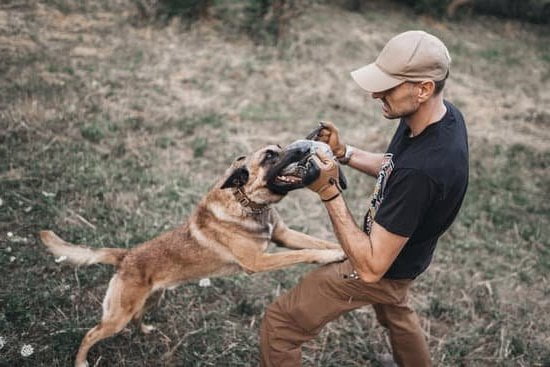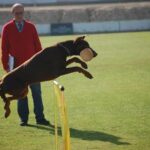Is your dog wreaking havoc in your home with destructive behavior and refusing to obey commands? It can be frustrating and overwhelming to deal with a disobedient and destructive dog, but there is hope. Understanding the behavior of a destructive disobedient dog is the first step towards effective training and behavior modification.
Destructive behavior in dogs can stem from various underlying reasons, such as boredom, anxiety, lack of stimulation, or even medical issues. By recognizing the triggers and patterns of your dog’s destructive behavior, you can start to address the root cause and develop a plan for positive change.
Establishing a consistent routine and environment for training is essential when dealing with a disobedient and destructive dog. This provides structure and stability that can help curb unwanted behaviors. Additionally, utilizing positive reinforcement training techniques and implementing obedience exercises are effective methods for addressing disobedience and destructiveness in dogs. With patience, dedication, and the proper guidance, you can successfully train your destructive disobedient dog.
Assessing the Root Cause of the Destructive Behavior
Understanding the behavior of a destructive disobedient dog is crucial in addressing and solving the issue. Destructive behavior, such as chewing on furniture, excessive barking, or soiling indoors, can be signs of anxiety, boredom, lack of exercise, or separation distress. It is important to note that these behaviors are often symptoms of an underlying problem rather than the primary issue itself.
Assessing the root cause of the destructive behavior requires patience and observation. It is essential to pay attention to when the behavior occurs, what triggers it, and how the dog acts before and after engaging in destructive activities. Keep a journal or log of these behaviors to identify any patterns or potential causes.
One effective way to address and correct destructive behavior in disobedient dogs is by implementing positive reinforcement training techniques. By rewarding good behavior with treats, praise, or playtime, you can encourage your dog to repeat those actions. This method not only helps in modifying negative conduct but also strengthens the bond between you and your pet.
| Training Technique | Description |
|---|---|
| Positive Reinforcement | Rewarding good behavior with treats or praise |
| Redirection | Redirecting the dog’s focus to an acceptable activity |
Establishing a Consistent Routine and Environment for Training
Training a destructive disobedient dog can be challenging, but establishing a consistent routine and environment for training is essential in addressing these behavioral issues. Dogs thrive on consistency, so creating a structured daily schedule for your furry friend can help reduce their destructive tendencies. This includes regular feeding times, walks, playtime, and training sessions. By providing a predictable routine, you can create a sense of stability and security for your dog, which can ultimately lead to better behavior.
In addition to a consistent routine, it’s important to create an environment that is conducive to training. This means removing any potential hazards or triggers that may contribute to your dog’s destructive behavior.
Keep valuable items out of reach, puppy-proof your home if necessary, and provide plenty of toys and activities to keep your dog mentally stimulated. A safe and comfortable environment will make it easier for your dog to focus on their training and learn new behaviors.
When establishing a routine and training environment, it’s crucial to be patient and understanding. It may take time for your dog to adjust to the new schedule and surroundings. Consistency is key – stick to the established routine even when faced with challenges. By doing so, you are setting the stage for successful training outcomes as you work towards curbing your dog’s destructive disobedient behavior through positive reinforcement techniques.
As you navigate through the process of establishing a consistent routine and environment for training your destructive disobedient dog, keep in mind that every step forward – no matter how small – is progress in the right direction.
Positive Reinforcement Training Techniques for Disobedient Dogs
When dealing with a destructive disobedient dog, it is important to utilize positive reinforcement training techniques to encourage good behavior. Positive reinforcement involves rewarding your dog for exhibiting the desired behavior, which can be a powerful tool in modifying their actions. Here are some effective positive reinforcement techniques to consider when training your disobedient dog:
- Use treats: Offering your dog a small, tasty treat when they follow a command or exhibit good behavior can be an effective way to reinforce positive actions.
- Verbal praise: Dogs respond well to verbal praise and affection from their owners. Offering enthusiastic verbal praise when your dog behaves well can motivate them to continue the positive behavior.
- Clicker training: Clicker training is a popular positive reinforcement technique that involves using a clicker to make a distinct sound when your dog performs the desired behavior, followed by offering a treat as a reward.
By consistently employing these positive reinforcement techniques, you can effectively train your disobedient dog to exhibit better behavior and reduce destructive tendencies.
In addition to positive reinforcement, it is important to remain patient and consistent in your training efforts. Dogs thrive on routine and structure, so establishing a consistent environment and training schedule will help reinforce the desired behaviors. Remember to also provide mental stimulation and physical exercise for your dog to prevent boredom and reduce destructive tendencies.
Seeking professional help from a certified dog trainer or behaviorist may also be beneficial, especially in extreme cases of destructive disobedience. A professional can provide personalized guidance and support for addressing your dog’s specific behavioral issues. With patience, dedication, and the use of positive reinforcement techniques, you can successfully train even the most destructive disobedient dog and build a strong bond with them through training efforts.
Implementing Obedience Training Exercises
Obedience training is a crucial aspect of addressing the behavior of a destructive disobedient dog. It involves teaching your dog basic commands such as sit, stay, come, and down. These commands not only help in controlling your dog’s behavior but also establish you as the pack leader.
To start obedience training, find a quiet and familiar environment with minimal distractions. Begin with simple commands such as “sit” and “stay.” Use positive reinforcement techniques by rewarding your dog with treats or praise when they successfully follow the command. Consistency is key in obedience training, so make sure to practice these exercises daily for short periods of time.
It’s important to keep training sessions fun and engaging for your dog to prevent them from becoming bored or resistant. Rotate different exercises and use a variety of rewards to keep them motivated. With consistency and patience, your destructive disobedient dog can learn to listen and follow commands through obedience training.
As you progress with obedience training, gradually introduce more advanced commands and behaviors such as walking on a leash without pulling or staying in place for longer periods. Remember that every dog learns at their own pace, so it’s essential to be patient and remain consistent in your efforts. With time and dedication, you can successfully train a destructive disobedient dog using obedience exercises.
Addressing Destructive Behavior Through Redirection and Alternative Activities
When dealing with a destructive disobedient dog, it is important to address their behavior through redirection and alternative activities. This involves redirecting their focus and energy towards more positive and acceptable behaviors while providing them with alternatives to the destructive actions they tend to engage in. By doing so, you can effectively discourage destructive behavior and encourage healthier habits in your dog.
One effective way to address destructive behavior through redirection is by providing your dog with interactive toys and puzzles that will keep them mentally stimulated and physically active. Engaging your dog in activities such as playing fetch, hide-and-seek, or teaching them new tricks can also redirect their energy towards more positive outlets. These activities not only serve as a distraction from destructive behavior but also help in strengthening the bond between you and your pet.
Additionally, it is crucial to ensure that your dog has an appropriate outlet for their natural instincts and energy levels. For example, if you have a high-energy dog breed, providing them with regular exercise such as daily walks or runs can help in reducing their destructive tendencies. Moreover, mental stimulation through obedience training exercises or agility courses can also serve as productive alternatives to their destructive behavior.
| Training Approach | Effectiveness |
|---|---|
| Interactive toys and puzzles | Highly effective |
| Daily exercise | Effective |
| Obedience training exercises | Highly effective |
Seeking Professional Help and Guidance for Extreme Cases
Knowing When to Seek Professional Help
When dealing with a destructive disobedient dog, it is important to recognize when the situation is beyond your control and requires professional help. If your dog’s behavior is putting their safety or the safety of others at risk, if they are displaying aggressive tendencies, or if their destructive behavior is causing significant damage to your home, it may be time to seek the assistance of a professional dog trainer or behaviorist.
The Role of Professional Trainers and Behaviorists
Professional trainers and behaviorists have the knowledge and experience to assess your dog’s behavior, identify underlying issues, and develop a customized training plan to address their destructive disobedience. They can provide valuable insight into why your dog may be behaving in this manner and offer effective techniques for modifying their behavior.
Collaborating With Professionals and Implementing Their Recommendations
When working with a professional trainer or behaviorist, it is important to actively participate in the training process and follow their recommendations diligently. This may include implementing specific exercises, management strategies, and environmental modifications. By collaborating with these experts, you can gain valuable skills and insights on how to train a destructive disobedient dog effectively.
Professional help can make a significant difference in addressing extreme cases of destructive disobedience in dogs. Remember that seeking guidance from a trained expert does not indicate failure as a pet owner. Instead, it demonstrates your commitment to providing the best possible care for your canine companion while ensuring the safety and well-being of everyone around them.
Consistency and Patience
Training a destructive disobedient dog can be a challenging and frustrating experience for many pet owners. However, it is important to remember that consistency and patience are key when it comes to successfully training a dog with these behavioral issues. This section will provide guidance on how to maintain consistency in your training efforts and the importance of being patient throughout the process.
Consistency in Training
One of the most crucial aspects of training a destructive disobedient dog is consistency. Dogs thrive on routine and structure, so it is important to establish a consistent training schedule and environment. This means setting regular times for training sessions, feeding, exercise, and playtime. Consistency also applies to the rules and boundaries you set for your dog. It’s essential that all members of the household enforce these rules consistently to avoid confusing the dog.
Patience in Training
Training a destructive disobedient dog requires an abundance of patience. It’s important to understand that behavioral change does not happen overnight, and progress may be slow at times. It’s easy to become frustrated when dealing with a disobedient dog, but losing your temper will only hinder the training process. Instead, remain calm and patient, offering positive reinforcement for good behavior and correcting unwanted behavior calmly but firmly.
Seeking Support
In some cases, despite consistent training efforts and patience, a destructive disobedient dog may still exhibit challenging behavior. When this happens, it’s important not to give up hope. Seeking professional help from a certified dog trainer or animal behaviorist can provide valuable insight into addressing your dog’s specific issues. These professionals can create a customized training plan tailored to your dog’s needs, providing additional support and guidance during this challenging time.
By remaining consistent, patient, and seeking professional support when needed, you can effectively train a destructive disobedient dog and build a strong bond with your pet through your training efforts.
This approach may require time but staying committed will surely yield results in due course”.
Celebrating Progress and Success
In conclusion, training a destructive disobedient dog can be a challenging and frustrating experience. However, by understanding the behavior of your dog and assessing the root cause of their destructive tendencies, you can begin to address these issues effectively. Establishing a consistent routine and environment for training, coupled with positive reinforcement techniques and obedience exercises, can help reshape your dog’s behavior in a positive way.
It is important to remember that consistency and patience are key when it comes to training a disobedient dog. It takes time for them to unlearn bad habits and replace them with more desirable behaviors. It is also crucial to celebrate any progress and success along the way, no matter how small. This not only reinforces good behavior but also helps build a stronger bond between you and your pet.
In some cases, seeking professional help may be necessary, especially for extreme or persistent destructive behavior. A professional dog trainer or behaviorist can provide guidance and support tailored to your dog’s specific needs. Ultimately, the effort put into training a destructive disobedient dog is well worth it as it not only improves their behavior but also strengthens the relationship between you and your furry companion.
Frequently Asked Questions
How Do You Discipline a Destructive Dog?
Disciplining a destructive dog requires first identifying the root cause of their behavior. Is it boredom, anxiety, or lack of exercise? Once pinpointed, addressing those underlying issues through proper training and positive reinforcement can help redirect their destructive tendencies.
How Do You Train an Extremely Disobedient Dog?
Training an extremely disobedient dog takes patience and consistency. Understanding the reasons behind their disobedience and using positive reinforcement techniques to encourage good behavior is essential. Obedience classes or working with a professional trainer may also be beneficial.
How Do I Get My Dog to Stop Destroying Everything?
To get a dog to stop destroying everything, it’s crucial to provide them with enough physical and mental stimulation. Regular exercise, interactive toys, and obedience training can help focus their energy in more constructive ways. Additionally, crate training and managing the environment to minimize temptations can be helpful in curbing destructive behavior.

Welcome to the blog! I am a professional dog trainer and have been working with dogs for many years. In this blog, I will be discussing various topics related to dog training, including tips, tricks, and advice. I hope you find this information helpful and informative. Thanks for reading!





